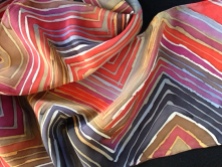Poly-heading
No, that’s not something that nasty pirates do*. It’s me, head-switching again. There’s a copy deadline coming up for the Journal for Weavers, Spinners and Dyers so I have had temporarily to drop the write-up of the DHA paper. I also need to continue making scarves. One is a commission (yes, RD, there will be a choice for you!) but also a batch for the Burton Gallery and Museum, Bideford, where I am demonstrating working with wax all day on 14th December as part of their Meet the Burton Makers family programme.
The Burton Gallery and Museum, Bideford, Devon
I am a devoted fan of the Burton Gallery and Museum. I urge anyone visiting Bideford to go. I happen to love the ceramics of North Devon; they have an excellent permanent display from the RJ Lloyd Collection and I never tire of looking at it. Related to the collection is a brick-built bottle-kiln adjacent to the Gallery in Victoria Park and wood firings regularly take place there. In the images above you can see a sherd of pottery I found in our vegetable patch. There is an entire plate with almost the same pattern in the RJ Lloyd collection, dated to the 16th century, so my find is rather special and I keep looking for more of it under the carrots and chard. The historic Devon pottery tradition carries on today with the work of many local potters, including that of Clive Bowen. We have several pieces of his work at home.
The Burton has a permanent collection of watercolours and drawings containing evocative marine and local scenes but also shows touring art exhibitions of international standard. It also has rather a good and child-friendly French café…
Wax resist work
The images of the scarf in progress show the final layer of dye applied over about five layers of wax and dye. You will see that in two images there are beads of dye on the wax surface. On other images they have been removed. This is because if they dry on the wax surface, they will eventually deposit themselves on the silk when the wax melts out and I don’t like the often fuzzy, mottled effect this produces. So I wipe it off, carefully. Minute quantities of residual dye attach themselves to the textured surface of waxed shapes which produces unpredictable but often subtle textures. These I do like. The wiping-up process is rather like cleaning an etching plate before printing: I do it in a whizzy, upwards, circular motion. Thank you Mr Sellars, who taught me how to do this fifty years ago.
* Apologies to those reading this whose mother tongue isn’t English. Poly-heading is meant to be a joke – a pun – because ‘Polly’ is the name people often give to pet parrots, and as we all know parrots always sit on old-fashioned Long John Silver-type pirates’ shoulders saying ‘Pieces of Eight’. A pirate might want to knock its head off if it went on and on…
The other thing we all know is that when one attempts to explain a joke, it ceases to be in any way amusing…



















